Blockchain and Artificial Intelligence: technological and regulatory convergence on the horizon?

By: Daniel Peña Valenzuela
The digital ecosystem continues to grow as a result of the increasing volume of data created in the information society and the latest technologies developed as a result of an unprecedented wave of investment, as well as technology startups and companies committed to innovation. Public policies try to keep pace with the speed of technological advancement, but achieving the necessary consensus at the governmental level is difficult. However, the relationship between technocracy and political decision-making is called into question by the progressive view that sometimes sees a lack of coherence between the goals of academia, mainly research at universities and private think tanks, and national goals. Laws on these issues remain examples of multiple projects that have failed in their conception and pragmatic development. Legislative bodies sometimes lack the expertise to synthesize and resolve the main problems between technology and law.
Blockchain and artificial intelligence (AI) are two innovative and disruptive technologies that, although different in their applications and functionalities, can complement and benefit each other in certain contexts. Both technologies are constantly evolving, and their convergence has the potential to transform various sectors such as data management and analytics, cybersecurity, and the traceability of the global e-commerce supply chain.
Solutions are being developed to address scalability challenges in blockchains, enabling higher performance and wider adoption. This could facilitate the management of large amounts of data needed for training AI models.
For its part, the creation of standards and protocols that improve interoperability between different blockchain platforms would facilitate the transfer of data and assets between systems, benefiting artificial intelligence applications. Protocols and standards such as ERC-20 (Ethereum Request for Comments 20) for tokens or the Hyperledger Fabric standard are examples of standards that allow different blockchains to work together.
The mechanisms are diverse; a chain bridge is a mechanism that allows the transfer of assets or data between different blockchains. This facilitates interoperability by connecting different blockchain ecosystems and allowing assets to move from one chain to another securely. Likewise, robust and standardized application programming interfaces (APIs) can be provided to facilitate communication and interaction between different blockchains. Well-defined APIs allow developers to build applications that can run on multiple blockchains.
TECHNOLOGICAL INTERRELATIONSHIP BETWEEN BLOCKCHAIN AND ARTIFICIAL INTELLIGENCE
Security and trust:
Blockchain provides a decentralized and secure system for data storage. The immutability of records on the blockchain helps prevent information manipulation. As a result of the blockchain, smart contracts have emerged, which are autonomous computer programs that automatically execute agreements when certain conditions are met. The interoperability of smart contracts involves the ability to execute contracts on different blockchains, enabling collaboration and process automation across chains.
Some solutions seek to achieve interoperability through consensus mechanisms that span multiple blockchains. These mechanisms allow different blockchains to agree on the state of the network and the validity of transactions.
Artificial Intelligence can use secure data stored on the blockchain to train models reliably, as the data cannot be altered once it is recorded on the blockchain.
AI can contribute to the formation of consortia and alliances between different blockchain projects and can foster interoperability by establishing shared rules and standards that facilitate collaboration between the parties involved.
Data management:
Blockchain offers an efficient and secure way to manage and share data between different parties without the need for an intermediary.
AI requires large amounts of data to train effective models. Blockchain can be used to guarantee the origin and authenticity of the data used in training AI models.
One of the fundamental characteristics of blockchain is immutability, which means that once information is recorded in a block, it cannot be modified. This can be a challenge when it comes to personal data, as any errors or incorrect sensitive information initially recorded cannot be easily corrected.
While cryptocurrency addresses on a blockchain are pseudonymous, some blockchain systems may have features that allow addresses to be linked to real-world identities. Managing user privacy and anonymity is crucial to protecting personal information.
The inclusion of personal data on a blockchain must be supported by the informed consent of individuals. Users must understand how their data will be used and what implications the immutability of information on the chain may have.
Since blockchain is transparent and accessible to all participants, it is essential to ensure that personal data is encrypted and protected. Information security must be a priority to prevent unauthorized access.
Asset tokenization and smart contracts:
Blockchain enables the creation of tokens and smart contracts, facilitating the representation and automation of agreements and transactions.
AI can leverage tokenization to improve efficiency in contract and transaction execution, as well as in digital asset management.
Privacy protection:
Blockchain can provide greater control over privacy and data access through mechanisms such as encryption and decentralized key management.
AI can benefit from the enhanced security and privacy offered by blockchain when handling sensitive data during model training.
Incentives and rewards:
Blockchain enables the creation of reward systems and tokens that can motivate user participation and contribution.
AI can use these incentives to improve the collection and quality of data used in AI model training.
Together, the combination of blockchain and AI can contribute to a more secure, transparent, and efficient digital ecosystem, especially in situations where trust, data integrity, and automation are crucial. Both technologies are constantly evolving, and their interrelation remains a challenge for public policies that tend to balkanize their study and take the technologies separately to regulate them or create legal or ethical standards in this regard.
INTERRELATIONSHIP BETWEEN THE LEGAL REGULATION OF BLOCKCHAIN AND AI
The legal and public policy regulation of blockchain and AI may have similarities in some respects, but there are also likely to be significant differences due to the distinctive characteristics of these technologies.
Blockchain Regulation:
Data and Privacy:
Privacy and data protection regulations apply to both blockchain technology and AI. However, the decentralized nature of blockchain, where data is stored in a distributed manner, may require specific approaches to ensure privacy and data protection.
Smart Contracts:
Regulation tends to focus on smart contracts and the legal validity of transactions carried out through them. It also addresses issues of liability in the event of errors in the execution of smart contracts that affect their effectiveness or enforceability. The testing of smart contracts as data messages should also be taken into account, no longer for their authenticity or integrity but for their content.
- Tokenization and Cryptocurrencies:
The regulation addresses the issuance, marketing, and use of tokens and cryptocurrencies, including the prevention of money laundering and the protection of investors through supervision, surveillance, and control mechanisms.
- Interoperability and Standards:
It is important that public policies on ICT take a holistic view that allows for interoperability between different blockchains and the establishment of standards to facilitate integration with existing systems, such as artificial intelligence applications.
Artificial Intelligence Regulation:
Ethics and Responsibility:
AI regulations focus on ethics and responsibility. They also include aspects such as transparency in algorithms, the explainability of AI decisions, and the assignment of responsibility in the event of negative outcomes.
Data Protection:
Data protection laws may apply to AI technologies due to the collection, compilation, and processing of large amounts of information, much of which is personal data. The use of data to feed, train, and enhance artificial intelligence systems requires user consent and authorization and the establishment of rules on how personal data is handled that comply with local and international principles and standards in this area.
Bias and Discrimination:
AI regulations address algorithmic bias and discrimination in AI systems, requiring development and training practices that minimize discrimination.
Security and Transparency:
AI regulation requires security standards for AI systems and the disclosure of information about the presence of AI systems in products and services.
Sustainable Development:
Regulations related to sustainability and environmental responsibility could apply to AI systems, especially those that consume large amounts of computational resources.
POSSIBLE AREAS OF REGULATORY CONVERGENCE:
Privacy and Data:
Both blockchain and AI handle data, but blockchain is generally associated with decentralized data protection, while AI may require specific regulations for ethical data handling and privacy.
Accountability and Transparency:
Both technologies may require regulations that address liability in the event of misuse or unintended outcomes. In addition, transparency in AI algorithms and traceability in blockchain may be common themes.
Emphasis on Innovation:
Regulations must balance user protection and the promotion of innovation, recognizing the transformative potential of both technologies.
In summary, although some areas of regulation may overlap, the unique nature of blockchain and artificial intelligence may lead to specific regulations to address the challenges and opportunities of each technology. Regulatory authorities need to carefully consider the impact of these technologies on society and the economy when developing regulatory frameworks.
BLOCKCHAIN CYBERSECURITY IS RELEVANT TO AI
As a corollary to the above, cybersecurity is crucial for AI intelligence, as systems using this technology often work with large amounts of sensitive and personal data. Cybersecurity helps protect this information from unauthorized access, data theft, and cyberattacks that compromise individuals’ privacy. Artificial intelligence models are susceptible to manipulation attacks, where adversaries attempt to intentionally alter input data to deceive the model and obtain incorrect results. Cybersecurity helps ensure the integrity of AI models and confidence in their results. Cyberattacks can have serious consequences, especially in critical AI applications such as cybersecurity, healthcare, and transportation. Finally, AI systems are often deployed in online environments to provide real-time services, which makes them more vulnerable to cyberattacks. Cybersecurity is essential to ensure the continuous availability of AI-powered services.
PROSPECTIVE SCENARIOS FOR THE INTEGRATION OF BLOCKCHAIN AND ARTIFICIAL INTELLIGENCE
The futuristic scenarios for blockchain and artificial intelligence (AI) are promising, with the potential to significantly transform various aspects of society and the economy.
- Total decentralization: Blockchain technology is expected to play a crucial role in the decentralization of systems and services. This could lead to the elimination of intermediaries in various industries, such as finance, insurance, real estate, and professional services. Decentralization could also increase security and privacy.
- Tokenized economy: The creation of tokenized digital assets on blockchain could lead to a whole new economy, where tokens represent physical and virtual assets. This could change the way goods are bought and sold, as well as the way projects are invested in and funded.
- Advanced smart contracts: Smart contracts on blockchain could evolve to become more complex and autonomous. They could execute complex tasks without the need for human intervention, facilitating more secure and efficient transactions.
- Integration of AI and blockchain: The combination of artificial intelligence and blockchain could lead to smarter and more secure systems. AI could be used to improve transaction security, prevent fraud, and provide predictive analytics based on data stored on the blockchain.
- Sovereign digital identity: The integration of blockchain and artificial intelligence could enable the creation of sovereign and secure digital identities. Individuals could have complete control over their personal information and decide what data to share and with whom.
- Decentralized governance: Blockchain-based governance systems could enable more democratic and transparent decision-making in various organizations. Decentralization could be applied to governments, businesses, and sales.
- Decentralized neural networks: The ability to run and train neural networks in a decentralized manner could lead to significant advances in the field of artificial intelligence. This could improve the efficiency of machine learning and foster global collaboration in AI research.

Virtual employment contracts are valid under colombian law

International Joint Ventures (2013)



